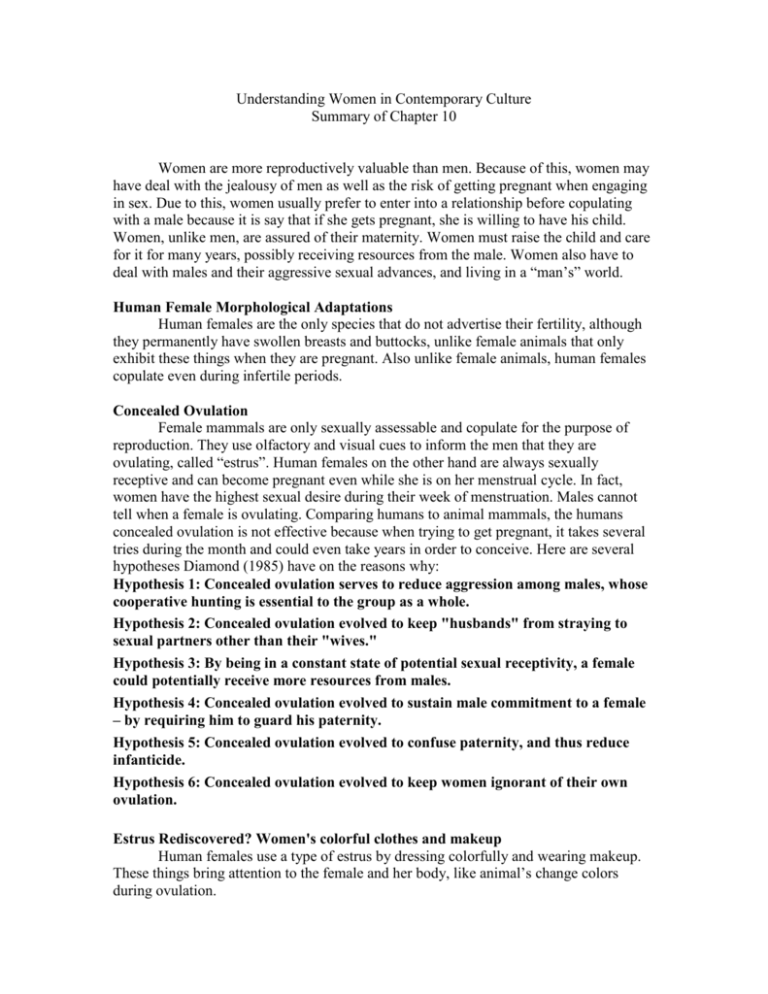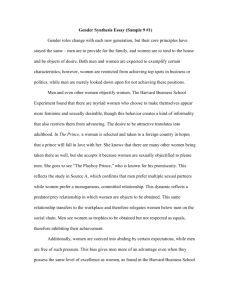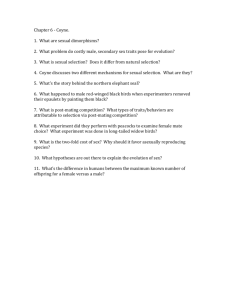Understanding Women in Contemporary Culture
advertisement

Understanding Women in Contemporary Culture Summary of Chapter 10 Women are more reproductively valuable than men. Because of this, women may have deal with the jealousy of men as well as the risk of getting pregnant when engaging in sex. Due to this, women usually prefer to enter into a relationship before copulating with a male because it is say that if she gets pregnant, she is willing to have his child. Women, unlike men, are assured of their maternity. Women must raise the child and care for it for many years, possibly receiving resources from the male. Women also have to deal with males and their aggressive sexual advances, and living in a “man’s” world. Human Female Morphological Adaptations Human females are the only species that do not advertise their fertility, although they permanently have swollen breasts and buttocks, unlike female animals that only exhibit these things when they are pregnant. Also unlike female animals, human females copulate even during infertile periods. Concealed Ovulation Female mammals are only sexually assessable and copulate for the purpose of reproduction. They use olfactory and visual cues to inform the men that they are ovulating, called “estrus”. Human females on the other hand are always sexually receptive and can become pregnant even while she is on her menstrual cycle. In fact, women have the highest sexual desire during their week of menstruation. Males cannot tell when a female is ovulating. Comparing humans to animal mammals, the humans concealed ovulation is not effective because when trying to get pregnant, it takes several tries during the month and could even take years in order to conceive. Here are several hypotheses Diamond (1985) have on the reasons why: Hypothesis 1: Concealed ovulation serves to reduce aggression among males, whose cooperative hunting is essential to the group as a whole. Hypothesis 2: Concealed ovulation evolved to keep "husbands" from straying to sexual partners other than their "wives." Hypothesis 3: By being in a constant state of potential sexual receptivity, a female could potentially receive more resources from males. Hypothesis 4: Concealed ovulation evolved to sustain male commitment to a female – by requiring him to guard his paternity. Hypothesis 5: Concealed ovulation evolved to confuse paternity, and thus reduce infanticide. Hypothesis 6: Concealed ovulation evolved to keep women ignorant of their own ovulation. Estrus Rediscovered? Women's colorful clothes and makeup Human females use a type of estrus by dressing colorfully and wearing makeup. These things bring attention to the female and her body, like animal’s change colors during ovulation. The female orgasm: Byproduct or expatation? There is disagreement about the reason that women receive orgasms. The first is that it is adaptive and helps the female with fertilization, and the other is that it is a physical byproduct from male’s ability to orgasm. After insemination, women reject 35 percent of the sperm, but when a woman has an orgasm during copulation, she retains 70 percent, only rejecting 30 percent. Although this is not a large percent difference, over generations a lack of orgasm could lead to the rejection of more sperm. An orgasm pulls sperm from the vagina and into the cervical canal and uterus. The ability to orgasm during copulate shows that the female is attracted to the male and a female in a loving relationship is more likely to have more orgasms. A possible explanation for the reason women receive orgasms is because the clitoris and the penis stem from the same cells as a fetus, originally a clitoris but once masculinized turns into a penis. Permanently swollen breasts Female humans are the only mammals that have breasts from the time of puberty. Female animals only receive breasts when they are lactating. Human females are so different physically from animals that it is amazing that human males are attracted to the breasts of females. This may be because they use the breasts and buttocks as viewpoints of health because malnourished females have to use this reserve of fat to stay alive. They also serve to conceal ovulation, keeping the male interested and have a higher likelihood that he will provide resources if she does conceive. The hymen: What function? The hymen is a thin layer of tissue that covers the opening of the vagina and may be a genetic mutation due to its unknown purpose. It may have been created for men wanting to know if a female was a virgin, indicating a lack of sexual activity, proving their chastity. Menopause Menopause occur when a women stops menstruating, usually between 45 and 50 years old, creating an inability of conceiving. Campbell (1971) has two theories on whay this may occur. The first is that infants mature at such a slow rate that the women needs time to raise them before she gets too older. The second one is that elderly people bring more wisdom to society because they do not have children to raise. Alexander (1974) and Dawkin (1976) feel that it helps a woman to devote more time to her children and grandchildren, referring to the Grandmother theory of menopause, that a woman will have more grandchildren than children of her own. Also, in earlier centuries, humans did not live past the age of 50. Many animals do not live long enough to reach infertility. Slow reproductive rate: Human female psychological adaptations Females have more to loose from poor mating than do males, adding pressure to select a mate with good genes. Female Problem: Selecting a good genetic partner Potential Solutions: -Women look for superior genes, so that they may be passed on to her offspring -Avoid incestuous mating: it may cause inbreeding depression and take up reproductive time. The father is usually hidden, leaving the mother to raise the child on her own, making her unattractive to mates. Incest usually occurs between generations. -Look for good signs of health: unhealthy men risks: -higher chance of dying prematurely, risking losing resources -could pass on disease or viruses -offspring could be infected by disease -unhealthy mate passes on unhealthy genes -care of mate may drain resources Good health is looked for in all cultures around the world (Buss et al. 1990). Possible ways to tell if someone is healthy: face symmetry. Female Problem: Selecting a good social partner Potential Solutions -Looking for good behavior: Buss et al (1990) found that a person of good character who is emotionally stable was the thing most desired from a mate after love. In all cultures, women valued this more than men. Emotionally unstable men can be harmful to the wellbeing the offspring because they show high rates of jealousy, dependency and moodiness. Looking for these good traits in mainly found when a woman is interested in a long-term relationship (short term does not really need this). -Look for males who are willing to commit to a long-term relationship: females invest more in reproduction and need a mate that will provide for her and the offspring. Women that only commit to short term run the risk of having to raise the child by herself while providing resources for both of them. -Put suitors through “tests” to assess their degree of commitment: women test men to see their “father potential” and if they pass, then they will make better mates -Make sure the male considers you to be ‘special’: this way his desire to seek other women will not be as present. -Sham detection: women have developed devices to tell if a man is lying about his commitment, helping to guard the female from being abandoned. -Make sure a male is not secretly committed to another woman, or is unwilling to break former commitments: best interest form woman to be in a monogamous relationship. From a study by La Cerra (1994), it was found that men think women standing alone are equal in attractiveness to those holding a baby. -Getting males to compete (choose the winner): by choosing the winner, females are getting the best genes for their offspring. -Evaluating male status and dominance: Men in power have greater reproductive success, passing superior genes to the offspring, causing the offspring to have greater reproductive genes. They also provide a lot of resources. Power is more important than attractiveness sometimes in a relationship because it is linked to better resources. This can be found in Buss and Barnes’ (1986) study. -Older males: correlates with social status. Buss and Schmidt’s (1993) study shows that internationally women prefer men to be about three and half years older than them. With age come more experiences and more money. The negative side is that older ages of males do not correlate with high rates of fertility. -Good looks as related to male status: reveal health and good genes, but may be more important in a short-term relationship. Good looks do not correlate with good health, but it along with symmetry and testosterone-traits, have become desirable to women over generations. Looks decline more gradually in men than women. Women place high value on men’s height. A man who is not immediately attractive may become more attractive to a female if he shows valued characteristics and traits. -Looking for males with good social skills and intelligence: in order to assess male’s potential to invest in children, a female predicts a male’s future success over his present success. Females also predict success of qualities like intelligence and skillfully negotiating social situations. -Reserving sexuality to a relationship context: poor mating can be detrimental to a female and her reproductive potential as well as the success of the future generations. Risks of short-term relationships are that she may become pregnant with a poor quality mate and may become known as promiscuous. Females usually carry a more conservative view of sex than males ( Del Thiessen 1994), becoming sexually active later than males and not as likely to engage in extra martial affairs, masturbation and homosexual behavior. Females Problem: Attracting the nest possible male Possible Solutions: Women across cultures participate in extra marital affairs if they are dissatisfied with their husbands. This is due to tow reasons: revenge and dissatisfaction. There is a correlation between low sexual satisfaction and low relationship satisfaction (Blumstein and Schwartz 1983). When a woman orgasms, so is showing faithfulness to her partner, possibly a reason why women may fake it. Arousing male sexual interest to initiate a relationship Behavioral signs attract a person. Flirting is a way to achieve this. For example, both men and women may maintain eye contact, but meals for the other, enhance body odor, tossing of hair, licking lips. They can attract a specific mate or draw in a group. Pheromones are used as a communication tool because the bacteria that is created forms in the sweat glands and gives off a unique smell. Women have high sexual peaks during their menstrual cycle and low periods during the mid-cycle. Protecting One’s ‘reputation’ Women may tarnish their reputation when in short-term relationships, decreasing males interest in them for long term relationships because they may be unfaithful. Indication of health and beauty for women can be found through “enhancing physical attractiveness” and “dressing seductively”. Problem: Female-Female competition for mates It is a desire for reproductive success and survival- gaining resources. Women try to enhance themselves physically to make themselves more appealing to more resource advantageous men. Potential Solutions: -Verbal derogation of rivals: when women fight each other, it is usually for the resources and sexual access of the male or protecting their own reputation. Female Problem: Diverting male Physical and sexual aggression Potential Solutions: -Reducing aggressive signals/displaying receptivity and/or vulnerability: female choice has caused males to be more aggressive and larger, but they can injury children due to this. -Female coalitions: when band together to protect themselves from rape -Possible anti-rape adaptations: women that are ovulating and not using birth control are more likely to avoid situations that include rape (Chavanne and Gallup 1998). -Enforcing penalties for sexual harassment and rape: Women rely on family to revenge her attacker. Female Problem: Getting a Male to invest in her offspring Human males invest in their offspring more than other male mammals. Good male maters provide good genes, time and resources, which all depends on the certainty of his paternity. Potential Solutions: -Finding resource rich males attractive: women weigh financial prospects twice as much in a relationship than males do. -Finding potential ‘good father’ behavior attractive: women are fond of men that have a fondness for children. Courtship Feeding Sneaky solution: cuckoldry In every culture some women engage in extramarital affairs. She may do this to gain resources or a genetically superior mate, and she can access a higher status male. Female Problem: Choosing the best time for pregnancy Maximum fertility of women is between the ages of 20 and 30. Potential Solutions: -Contraception, abortion and infanticide: these increase reproductive rate over time. If women participate in these things earlier in life, they are less likely to participate in them later on when they are ready for pregnancy. Female Problem: Investing in their offspring Potential Solutions: Women can stop reproduction under stressful situations and resume it when they feel it is more appropriate to get pregnant. This especially happens when a women is too stressed to eat and loses a lot of body fat, making her unable to menstruate. This is also caused with anorexia. The ovarian system maintains nutrition, energy expenditure and balance, and aerobic activity. Endurance sports provide a more strenuous condition on the female body and may cause her to stop ovulating. Family related stress can stop ovulation as well. Anorexia is more prominent among girls who have been raped, a victim of incest or are single mothers. When women feel that it is the right time to get pregnant 15-25% of some who are trying to conceive do so within a month, 50% within six months, and up to 90% after 12 months. Miscarriages stop the physical material aspects and allow the mother to start conceiving again soon. Older women who get pregnant have a higher chance of developing an abnormal fetus. Lactation is a natural way to space out births, so that each infant gets the right amount of nutrients needed to survive. Sex-ratio manipulation There are more males born than females born, but due to the increased fatalities that males encounter, the populations of both sexes seem to even out in the end. It may be possible for women to manipulate the sex of her child (Grant 1998). This is called the Trivers-Willard model of sex ratio determination. Parents with higher status and more resources tend to have more sons, which are found in both human and animal species, supporting the Sexy Son’s Hypothesis. Low income families tend to have more girls so that they can marry up in status and have better genes for her offspring.







